
|
John Land★ (1818-1877) a Brief Biographical Sketch Birth: Son of Charles Lewis Land and Anne Dinsdell, Leeds, Yorkshire, England 1818. Occupation: Clothdrawer First Marriage: Mary Dyson, Leeds, Yorkshire, England 1840 Children of first Marriage - six: John (1841), Samuel (c. 1843), William (1847), Elizabeth Ann (1849), Charles Lewis (1852), James Dunford (1855)Widowed: 1857 Second Marriage: Lydia Law, Gomersal, Birstall Parish, Yorkshire, England 1857 Children of Second Marriage - eight: Law (1858), Albert (1861), Percy (1862), Arthur (1864), Harry (1867), Adelaide (1868), Polly (1871), Walter (1873)Death: Batley, Yorkshire, England 1877 John Land is my great great grandfather - Maggie Land Blanck
Birth, 1818, Leeds John Land, the son of Charles Lewis Land and Anne Land of Leeds, was born on May 5, 1818 and baptized on July 12, 1818 at Queen Street Chapel, Leeds. (Queen Street Chapel Records LDS microfilm 0828139). Queens Street Chapel was a congregational parish. Congregationalists were also called non-conformist or dissenters. Anne Land was the former Anne Dinsdell.
Occupations of John Land and his father, Charles Land On almost every documents that included an occupation John Land and his father, Charles Land, were listed as "cloth drawers". I have found two exceptions for John Land:
Throughout most of his life John Land was listed as a "cloth drawer" as was his father, Charles, before him. I have found several definitions for "drawing" and "cloth drawer".
"finishing or dressing the cloth is the next and last process of importance: it may be considered as including burling and drawing"Although Judd described most of the steps and occupations in the process of making woolen cloth and shoddy, he never described the process of "drawing". He did say that there were 70 "drawers" in Batley in 1858 and that they made 30 shillings a week. This was one of the highest paid jobs connected with the shoddy business that Judd listed. Judd also:
In a further attempt to determine exactly what a cloth drawer did I wrote to Museums and Libraries in England including Leeds Local Studies, The Bradford Industrial Museum, the Armley Mill Museum: They seem to think that a clother drawer worked in the finishing process: "I'm afraid I'm not able to give as much time to your enquiry as I'd like but I would err towards your ancestors working in finishing. I suspect if they were drawing on the loom at an earlier stage they would be referred to as woollen or worsted drawers as the cloth hadn't been made yet. Finishing workers also tend to get paid highly, especially those who are burling and mending - sadly most of our text books are technical and ignore the manual processes quite often but I would suggest that as your ancestors were also dressers then drawer as mender is probably the most likely definition."Volume II of "The Civil, Ecclesiastical, Literary, Commercial and Miscellaneous History of Leeds, Bradford, Wakefield, Dewsbury, Otley and the District within Ten Miles of Leeds" by Edward Parsons (1834) which examines the effect of industrial working conditions on public health states: "Cloth-drawers, men who with needles draw up minute holes or repair injuries in the cloth, are kept almost all day with the spine curved, and the abdomen consequently compressed. In lettering, especially, the men are obliged to lean forward. Cloth-drawers sometimes sit, with short intervals only for meals, from five in the morning till eight at night. The air they breathe is often too confined; and occasionally, when working low-priced goods, they are annoyed with the dust from fullers' earth. Cloth-drawers are generally delicate, short-breathed, and subject especially to stomach complaints and headache. These indeed we found to affect in a greater or less degree more than one-half the men we examined. The eyes frequently become inflamed, particularly in drawing scarlet. No cloth-drawers live in health to a great age. Cloth- drawers earn high wages, and, though occasionally required to work closely and for an improper period, they have frequent intervals in which not Half the day is devoted to labour.In June 2011 I found THE CLOTH DRAWERS CRAFT in a Google Book from 1908 that gives a lenghty discription of the "art" of cloth drawing with illustrations. This is about the only branch of textile finishing for which there is no literature. Articles more or less comprehensive have been written on every process with the exception of the drawer's art, and text books ignore it altogether. As it is a handicraft which requires a long apprenticeship and skill in manipulation, recipes and formulae cannot be given. |
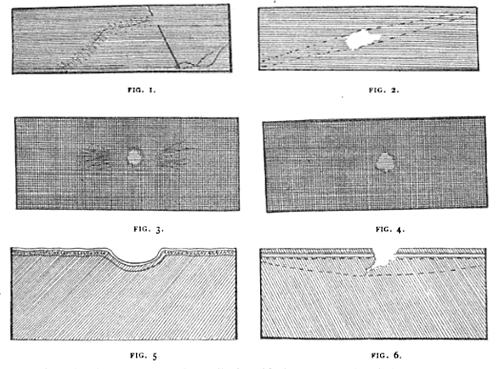
|
A Cloth Drawer was also know as a Fine Drawer". In speaking of impurities and foreign particles in the fleece: If twisted into the thread and wrought with the substance of the cloth they become the object of the burler's notice, who leaves, for every particle which is extracted, a hole in the piece to be repaired at the fulling mill, or by the nicer operation of the fine drawer.Another reference to the drawer's occupation as "fine drawer": The cloth might probably at this stage be examined by the fine drawer and finishing burler, after which" it is pressed and steamed."It was also known as "Reentering", "rent mending", "invisible mending" and "finishing".
Cloth Dresser John Land was listed in the 1842 Leeds Directory as a Cloth Dresser. Cloth Dressers were woolen workers who cropped the nap of the cloth after it was fulled. This was one of the last steps in the process and it is quite possible that the Lands were both dressing and "drawing" the cloth. "Cloth-dressers or Croppers, working at the shears, seem to be little injured by their employment; they are, however, too much crowded, and hence they occasionally suffer from disorders of the stomach. Affections, termed rheumatic, are also rather prevalent. We found few cloth-dressers aged; indeed in one large establishment they were almost all lads. This, however, results chiefly from the introduction of, "cutters" or the dressing cloth by machinery, in which old men are rarely employed. By the confinement, indeed, rather than by the nature of the occupation, is health affected."Cloth Draper John Land was listed as a cloth drapper at this second marriage in 1857. I believe that a "cloth draper" was a clothier or woolen cloth maker. The Lands as Cloth Drawers A 1822 Gazetteer of York County does not have any listings for Charles Land. John was only 4 years old at the time. There were, in fact, no listings for Cloth Drawers under a heading of Cloth Drawers. But there were a number listings under individual names. There were categories for: Cloth Dressers, Cloth Friezers and Cloth Glossers listed in Leeds in 1822. Cloth dressers AKA as shearers and croppers cut the nap of the woven cloth. Friesers raise the nap on the cloth. Glossers smooth the cloth by dragging it over hot irons. Neither John nor Charles Land were listed in the 1837 Gazetteer in Leeds. Again there was no separate listing under PROFESSIONS for Cloth Drawers, although there were individuals listed as such. Class, sect, and party: the making of the British middle class: Leeds, 1820 to 1850 By Robert John Morris states that there were 85 cloth drawers in Leeds in the 1834 Trade directory. I do not know if this included Charles Land. John Land was listed as a cloth dresser at Back Nile Street in the 1842 Leeds Directory.
In the 1853 Leeds Directory there was no listing for Cloth Drawers. I believe that cloth drawers were master tradesmen who served a seven year apprenticeship. I have not determined if they worked on their own premises or if they worked in the mills. Since there did not seem to be a need for advertisement in the trade gazetteers, I would assume that they worked in the mills. I also have the impression that cloth drawers may have worked in a factory setting as "overlookers" of a group of burlers who were mostly females. In the USA fine drawers worked at the fulling mill.
It appears that the cloth drawer worked closely with the cloth dressers. And he may have worked in the cloth dressers shop. Literacy John Land was literate enough to sign his name at the times of his marriages and the births of his children. His first wife, Mary Dyson, signed with her mark, indicating that she could not write. His second wife, Lydia Law, was literate enough to sign her name at the time of her marriage and the births of several of her children.
Note: There were people who could read but could not write. The Marriage of John Land and Mary Dyson, 1840 Leeds John Land, full age, bachelor, clothdrawer, of Holbeck, son of Charles Lewis Land, clothdrawer, and Mary Dyson, full age, spinster, Bell Street, daughter of Samuel Dyson, cloth dresser were married in the parish church of Leeds November 11, 1840. (Civil marriage record) The copy of the civil registration does not include the signatures but indicates that John Land signed his own name and Mary Dyson signed with her mark. The witnesses were Thomas Hoyle and R. H. Pickard. In July 2011 (thanks to Ancestry.com) I was able to obtain a copy of the Parish Record.
|

|
|
Mary Dyson The 1851 census indicates that Mary was the daughter of Hannah Dyson and that she was born in Huddersfield, Yorkshire circa 1820. The marriage certificate indicates that she was the daughter of Samuel Dyson, cloth dresser. Samuel and Hannah Dyson of Huddersfield had:
Samuel Dyson married Hannah Hoyle, August 13, 1804, St Peter's Huddersfield. Both made their mark. Note: Thomas Hoyle was one of the witnesses at the marriage of John Land and Mary Dyson,
Children of John Land, and Mary Dyson John Land and Mary Dyson had:
Marriage: In the 1901 census he was listed with a 19 year old wife named Harriett Land, Benjamin, Brown, Harriett, Dewsbury, 9b, 1270, Sep 1899 (Free BMD) 1899 Parish Church Birstall, July 5, Benjamin Land age 26 widower insurance agent, Blackburn Road, Birstall, son of William Land deceased tailor to Harriett Brown age 18 spinster, Church St Peter, Birstall daughter of Edward Brown wholesale butcher. Both signed. Witness Edward Brown. Children:
1881 Census: With his father. 1891 Census: Not listed 1901 Census: Benjamin Land, Birstall The Mount, Benjamin Land head, age 28, life insurance, born America F. S. USA, Harriett wife age 19, born Leeds, Clifford son age 2 born Morley, Elsie daughter 11 months, born Birstall 1908: Benjamin Land, Camberley Street 264 Dewsbury road to Rowland place South side #24 Land, Benjamin, insurance agent. (1908 Kelly's Directory, Leeds) Listed several ways. 1911, Hunslet: LAND, BENJAMIN, HEAD, MARRIED, M, 38 INSURANCE AGENT, U S A RESIDENT, LAND, HARRIET, WIFE, MARRIED, 11, F, 29 HOUSEWIFE, YORKS LEEDS, LAND, CLIFFORD, SON, M, 12, SCHOOL YORKS, MARFAY, (Morley?) LAND, ELSIE, DAUGHTER, F, 10, SCHOOL, YORKS, BIRSTALL, LAND, PHYLLIS, DAUGHTER, F, 8, SCHOOL, YORKS, BIRSTALL, 24 CAMBERLEY STREET HUNSLET LEEDS County Yorkshire West Riding District Hunslet Subdistrict Hunslet Enumeration District 33 Parish Hunslet 1881 Census: With his father. Death: John William Land, age 8, March 1883, Dewsbury 9b 416 Deaths
Death: Fred Land, age 7, Wood Wele buried July 13, 1884 (Batley Parish Records)
1871 Census: William Land was listed in Batley in E.D. 11, page 36 as follows:
William Land in "America": William and Hannah spent some time in Philadelphia and returned to England.
Return to England: William and Hannah Land returned to Batley by 1875 and were listed with three children in the 1881 Census which indicates that William Land had:
1881 Census in Batley: William Land and his family were listed at 191 Wilson Building, Bradford Road, Township of Batley, Parliamentary District of Dewsbury, Parish of St. Thomas Church as follows:
Death of William Land: William Land age 35, tailor, of Wood Wele, was buried April 27, 1884 Batley Parish. Death of Ann/Hannah Collier Land: Hannah Land Birth Date: abt 1852 Date of Registration: Oct-Nov-Dec 1941 Age at Death: 89 Registration district: Dewsbury Inferred County: Yorkshire West Riding Volume: 9b Page: 749?????? 1891 Census in Batley: Did not find Hannah 1901 Census: I did not find any listings for Ann (Hannah) Collier Land in the 1901 indexes on line.
Birth:
Civil Record: Elizabeth Ann, the daughter of John Land, cloth drawer, and Mary, formerly Dyson, was born on November 8, 1849, Westgate Common, Alverthorpe with Thornes. The birth was registered on December 12, 1849 by Mary Land, mother, who signed with her mark.Further Records: I do not know what happened to Elizabeth Ann. The last real record I have for her was in the 1871 census with her brother, Sam. However: It is possible that Elizabeth Land also immigrated to Philadelphia. The Records for St Timothy's Parish in the Roxborough section of Philadelphia have a very limited number of entries for the name Land. This include:
Birth: Charles Lewis Land was named after his paternal grandfather. Civil Record: Charles Lewis Land, the son of John Land, cloth drawer, and Mary Land, formerly Dyson, was born on May 24, 1852, Westgate Common, Thornes. The birth was reported by John Land, father. Marriage: Charles Lewis Land, age 24, bachelor, warehouse man, George's Terrace, Field Lane, Batley, son of John Land, cloth drawer, and Hannah Gomersal, age 21, spinster, Batley Field Hill, daughter of David Gomersal (deceased), woolen spinner, were married December 24, 1876 in the Independent Chapel in Batley. They both signed their names. Witnesses were: Alfred Wildsmith (?) and Eliza Hirst. (Civil Record) Occupation: 1876 Warehouse man, 1891 General dyer and cleaner, 1901 insurance agent Children:
Addresses: Batley in 1878, Gloucester from at least 1880 to 1882, Keighley 1885 to 1901 1891 Census: In Keighley see Lands in the Censuses 1901 Census: In Keighley see Lands in the Censuses 1906 Marriage: Charles Lewis Land Date of Registration: Jul-Aug-Sep 1906 Registration district: Keighley Inferred County: Yorkshire West Riding Volume Number: 9a to the widow Eleanor Swire Shuttleworth 1911 Census: Charles Lewis Land, age 57 storekeeper in Eletruck???? works, born Wakefield, Elenor Land, wife, 52, domestic duties, born Keighley, married 5 years, John Swire Shuttleworth, son age 23, single, carpenter building Sarah Elizabeth Shuttleworth, daughter age 21 single, spinner, woolen manufacturer, Ada Winefred Shuttleworth daughter age 20, woolen manufacturer, George Henry Shuttleworth son age 19, overlooker, woollen manufacturer, children born Uetenhage ??? Cape Colony. Question: Why were Charles Land's own children, Gertrude, Wilfred, Percy and David not living with him? None of them married until after 1912.
Death: Charles L Land birth c 1853 death March quarter 1942 Keighley FreeBMD More on the Shuttleworths: In October 2011 Ian wrote that Charles Lewis Land was the second husband of Elenore Shuttleworth (nee Swire). Her first husband was Harry Shuttleworth, and there were four children: Ada Winifred, George Henry, Sarah Elizabeth Shuttleworth, and John Swire. The family story/myth was that Sarah & Harry went to Cape Colony as missionaries, had a daughter out there, and that Sarah & daughter (Sarah Elizabeth Shuttleworth) returned without Harry & he was never seen again.FIND A GREAVE (added by W Sutherland, July 2011) contains a picture of the tombstone of Harry Shuttleworth. Which reads: In Loving Memory Later Lands in Keighley: You may be interested to know that my mother's cleaning lady was "Mrs. Stell", and she lived on Fell Lane. There was also a mill on the North Beck (Stell's Mill), which was burned down around 1950. One of my school-friends married a Jean Land, so there were still Stells and Lands in Keighley in the 1950's-60's.
Birth: James Dunford Land was a name used in at least three generations of Lands. Charles Land and Elizabeth Dunford had a son named James and a son named Charles Lewis Land. Charles Lewis Land was the father of John (1818) who named his sons, James Dunford Land (1855). Civil Record: James Dunford Land, the son of John Land, cloth drawer, and Mary Land, formerly Dyson, was born March 8, 1855, Carlinghow, Batley. The birth was reported by Mary Land, mother, who signed with her mark. Marriage: James Dunford Land, age 21, bachelor, book binder, 21 Booth Street, Stockport, son of John Land, cloth drawer, and Mary Elizabeth Mickelthwaite, age 21, spinster, Cross Bank, Batley, daughter of John Micklethwaite, carrier, were married December 24, 1876 in the Independent Chapel, Batley. They both signed their names. Witnesses: John E Hirst and Mary Gomersal. (Civil Record) Note: Charles Lewis Land and James Dunford Land were married the same day. Occupation: book binder 1876, bookbinder and stationer 1881, draper 1891 and 1901 1910: Notice is hereby, that the Partnership here tofore subsisting between us the undersigned, James Dunford Land and Frank Clayton, carrying on business as Hearthrugs Manufactures, at Town-street, Batley Carr, in Batley, in the county of York, under the style or firm of "LAND AND NEPHEW," has been dissolved by mutual consent as and from the first day of January 1910. All debts due to and owing by the said firm will be received and paid by the said Frank Clayton, who will continue the business under the style of "Frank Clayton" - Dated 22nd day of February, 1910Frank Clayton was married to Annie Micklethwaite. Children of James Dunford Land:
1881 Census in England: James D. Land and family were listed in the 1881 Census at 223 Commercial St. in the township of Batley, Parliamentary District of Dewsbury in the Parish, Church as follows:
1901 Census in England: James D Land and family were listed in the 1901 Census in Knaresbrough Outer, St John the Baptist, York, West Riding as follows:
Note for 1901 Census: I could not read the address which Christine Walker in Jan. 2006, kindly imformed me is "Forest Moore". For information on the family of Mary Elizabeth Mickelthwaite go to Mickelthwaite now or at the bottom of the page. 1911 Census: LAND, JAMES DUNFORD HEAD, MARRIED, M 56, FANCY DRAPER, BATLEY YORKS, LAND, MARY ELIZABETH, WIFE, MARRIED, 33, F 56, BATLEY YORKS, STEPHENSON, ANNIE, SERVANT SINGLE, F 24, GENERAL DOMESTIC SERVANT, LEEDS YORKS, CROFT, ELIZABETH ANN, VISITOR, WIDOW, F 57, WEST BURTON, CROFT, ISABEL, VISITOR, SINGLE, F 27, HARROGATE YORKS, Address FOREST MOOR, KNARESBORO, County Yorkshire West Riding District Knaresborough Subdistrict Knaresborough Enumeration District 8 Parish Knaresborough Outer Death of James Dunford Land, 1932: Probate: LAND, James Dunford of Birkham Dene Woodlands-drive Harrogate died 26 February 1932 Probate London 26 April to Mary Elizabeth Land widow John Fearnley organist and Ernest Marshall Wilkinson saddler. Effects £4477 16s 2d
Death of Mary Mickletwaite Land: 1938 - Mary Elizabeth Land, Birth Date: 26 Mar 1855, Death Date: 22 Jun 1938, Stonefall Cemetery and Crematorium Harrogate, Harrogate Borough, North Yorkshire, England Spouse: James Dunford Land Mary Elizabeth Land of Birkham Dene Woodlands dive- widow - effects 5,342 pounds - John Fearnley organist and Ernest Marschall Wilkinson, saddler. Death Date: 22 Jun 1938 Death Place: Harrogate, North Yorkshire, England Probate Date: 13 Aug 1938 Probate Registry: London, England
1841 Census John was listed on Canning Street in Hunslet with his parents as follows: Charles Land 43 cloth drawer, Ann age 44, John age 25, cloth drawer, Elizabeth age 18, James age 14, Emma age 7. Mary Land age 20 her son John Land age 2 months were listed with John Scholefield age 35, woodsman, Eliza Scholefield age 30 and Allen Dyson age 15 at Westside Northgate Huddersfield.
Move from Leeds to Wakefield and then to Batley As indicated by the places and dates of births of Charles in Leeds in 1845 and William in Wakefield in 1847, the lands moved from Leeds to Wakefield between those dates. Why did they make this move at this time? John Land's work was connected to the woolen industry. In fact, woolen manufacturing in Wakefield was waning in the mid 1800s while it was rising in other towns in the district, particuarly in Leeds. Wakefield, considered as a clothing town, has fallen from its once high position: it has been superseded by other towns. Leeds, Halifax, and Wakefield were once the three great centres: the two former still retain their eminence; while Wakefield has given way, and Bradford and Huddersfield have risen to distinction. In Leland's time we are told that " Wakefield standeth now al by clothying;" and at a later period woollen cloth, stuff goods, and worsted yarn were the main products of the place; but now, although there are still woollen and stuff manufacturers in the town, the number of them bears but a small proportion to those in the other towns we have named. The wool-market, too, is gradually leaving Wakefield for Bradford. Wakefield, on the other hand, has greatly risen as an emporium for the com and malt trade, and also as a cattle and sheep market; so that the prosperity of the town has not declined, it has merely taken a different direction. As indicated by the places and dates of births for Charles Lewis Land in Wakefield in 1852 and James Dunford Land in Batley in 1855, John Land and his family moved to Batley between those dates.
1851 Census Wakefield John Land and family were listed at Clayton Hill, Alverhorpe cum Thornes (Wakefield) in the 1851 see Lands in the Censuses
Directory Listings for John Land John Land was not listed in Batley in the 1857 or 1863 Directory of Leeds. Batley was not included in the 1872 Directory of Leeds. Death of Mary Dyson Land Church Record: Mary Land of Havercroft, age 38, was buried in Batley parish March 21, 1857 (LDS film #1542210). Civil Record: Mary Land, wife of John Land, cloth drawer, died March 19, 1857, of consumption (certified), the death was reported by John Land, present at the death, King Street, Batley.
Marriage of John Land and Lydia Law★, November 7, 1857, Birstall Not quite eight months after Mary's death John Land married Lydia Law. John was about 16 years older than Lydia and had six children still living from his first marriage: John age 16, Samuel, age 15, William, age 9, Elizabeth Ann, age 8, Charles Lewis, age 4, and James Dunford, age 2. Lydia was 22 years old. Only 6 years older than John Land, Junior. One can easily see the advantage to John of this marriage. What was the advantage to Lydia?
|
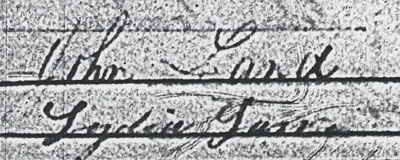 |
The signatures of John Land and Lydia Law from the parish register |
Notes:
Children of John Land and Lydia Law Lydia Law and John Land had:
1861 Census Batley John Land and family were listed at Wheats Croft Batley in the 1861 see Lands in the Censuses
Changes in the Naming Pattern for the Land Family With the exception of Law who was named for Lydia's maiden name, none of the children of John Land and Lydia Law were given names that appeared in the records up to that time. This represents a big break in the naming pattern in the Land family, who tended to name their children after their ancesters. It should be noted that family names were used with the children of the first marriage. It is only with the second set of children that new names enter the name pool. It is clear that new names were introduced into the family around the time of many other social changes. Some of these new names were used by several other branches and/or generations:
Frederick, Edna and Herbert were introduced in the next generation:
1871 Census Batley John Land and family were listed at Wood Wele Batley in the 1871 see Lands in the Censuses
Death of John Land John Land, age 59, cloth drawer, died on October 26, 1877 at Nussey Mill Yard, Batley, cause of death "probably apoplexy", reported by Lydia Land widow of the deceased, present at the death, Nussey Mill Yard, Batley (Civil Record) LDS microfilm 1482951 contains the death records for Batley parish cemetery from 1867 to 1967. John Land's burial was not listed. According to Webster apoplexy is, "A sudden and total loss of movement and consciousness, commonly called 'a stroke', due to rupture or clotting of one of the blood vessels in the brain"
Repercussions of the death John Land When John died in 1877 the children of his first marriage were all adults. The eight children from the second marriage ranged in age from 19 to 4 years old: Law born 1858, Albert born 1861, Percy born 1862, Arthur born 1864, Harry born in 1867, Adelaide born 1868, Poly born 1871 and Walter born 1873. How did Lydia manage? In the 1881 census Lydia was listed without an occupation. Albert and Percy, 20 and 18, were piecer in a woolen mill. Arthur, 16, was a cloth finisher and Harry, 14 was a mechanic spinning machine. There appears to have been four children supporting the family.
1881 Census Batley Lydia Land and family were listed at Nussey Mill Yard, Batley in the 1881 see Lands in the Censuses
|
Addresses for The Family of John Land in Leeds, Wakefield, and Batley The records indicate that John Land lived in the following places:
| |
| John Land was not listed in the Leeds directory in the village of Batley in the 1857
or 1863
Directory of Leeds.
Batley was not included in the 1872 Directory of Leeds.
The Name Land For information of the possible meaning and origins of the name Land go to The Name Land
The Lands in England The earliest known Land ancestor in this line was John Land born no later than 1746, place unknown. The first record connected to him was found in Wakefield in 1767. For an overview of the genealogy go to Land Ancestors
| |
| Law Land and Elizabeth Sykes Law Land, the son of John Land and Lydia Law, married Elizabeth Sykes in Batley, Yorkshire in 1880. They subsequently lived in Toronto, Canada, Detroit Michigan, Hoboken, New Jersey, Jersey City, New Jersey and Smithtown, Long Island. For more information on the family of Law and Elizabeth, and their life in America, click on their photo. |
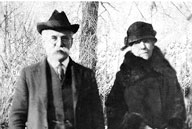
|
| Elizabeth Sykes Elizabeth Sykes was the daughter of George Stell Sykes. For more information on the Sykes go to George Stell Sykes | |
|
| |
| Charles Lewis Land, the father of John Land | |
|
| |
| The Lands in the English Censuses
For listings of the Lands in the censuses, click on the picture of the houses in Batley. |
 |
|
| |
| The Lands in Leeds To view pictures and maps of the areas in Leeds in which the Lands lived, click on the picture of Leeds from Holbeck |
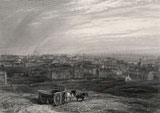 |
|
| |
| Photographs of Leeds To view photos of Leeds, click on the photos of St Peter's Church in Leeds. |
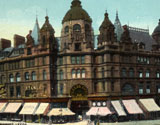 |
|
| |
| Wakefield, Information For information on the town of Wakefield, click on the photo of the old building in Westgate, Wakefield. |
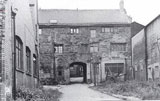 |
|
| |
| Leeds For information on Leeds, click on the photo of St Peter's, Leeds. |

|
|
| |
| The Laws For information on Lydia Law, and her ancestors click on the photo of Wellington Street, Batley. |
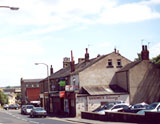 |
| MAPS of Leeds, Wakefield, and Batley, PHOTOS of Leeds, Wakefield and Batley, HISTORY, ORIGINAL DOCUMENT, AND OTHER INFORMATION |
| Mary Elizabeth Mickelthwaite was the wife of James Dunford Land (1855). For more information on the Mickeltwaites go to Mickelthwaite |
| If you have any suggestions, corrections, information, copies of documents, or photos that you would like to share with this page, please contact me at maggie@maggieblanck.com |
| Please feel free to link to this web page. You may use images on this web page provided that you give proper acknowledgement to this web page and include the same acknowledgments that I have made to the provenance of the image. Thanks, Maggie |
| ©Maggie Land Blanck - Page created 2004 - Latest update, September 2020 |